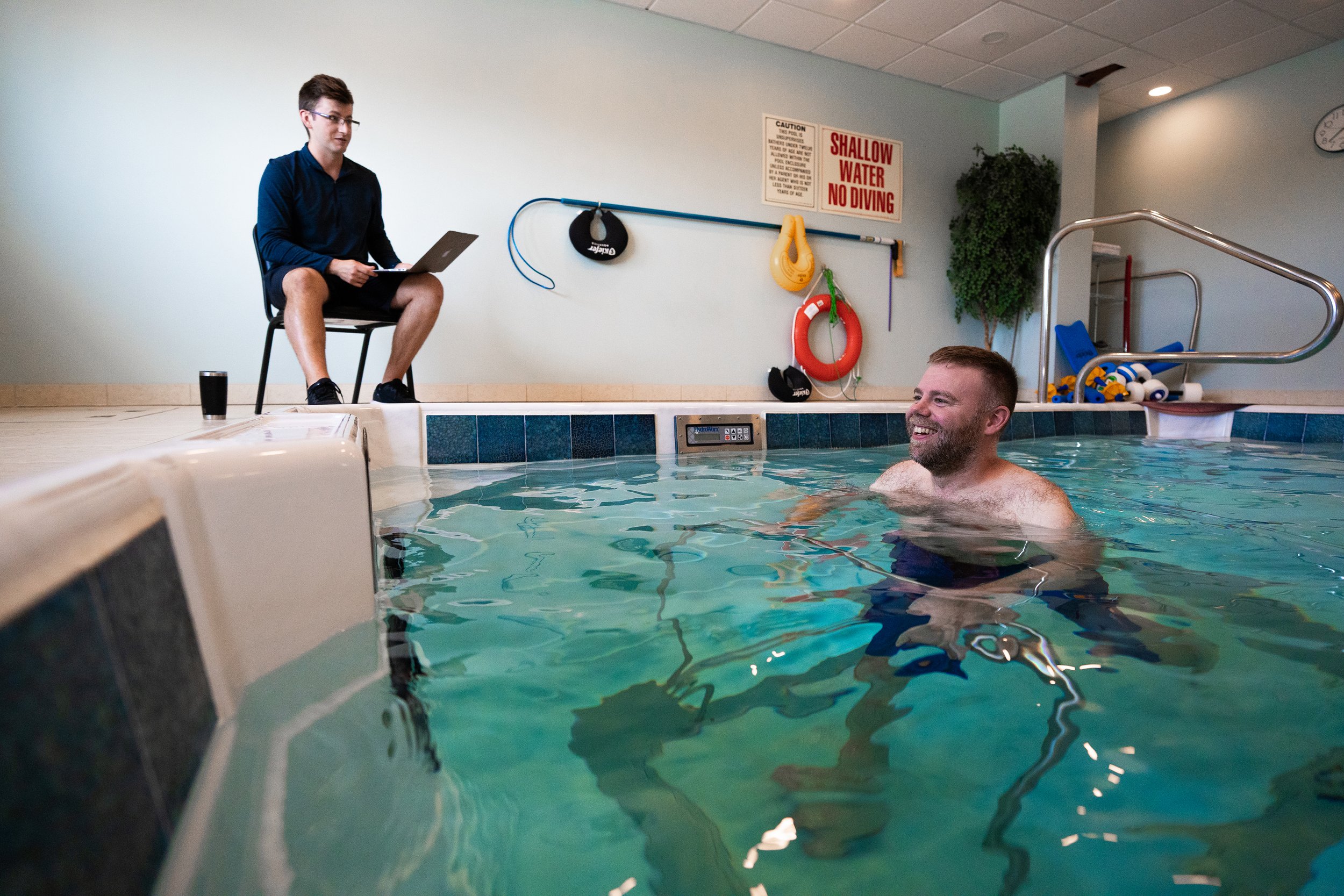Aquatic Therapy
Low impact with big results.
What Is Aquatic Therapy?
Aquatic therapy is a low-impact rehabilitation method harnessing the buoyancy of water to ease strain on the body during exercises, benefiting those with pain, mobility issues, or balance impairments.
How It Works
Submerging the body in water creates an upward force that eases the pressure of body weight, making aquatic therapy low-impact for exercise and rehabilitation. This gentle environment relieves strain on joints and ligaments, empowering those with pain or mobility issues to do exercises that are otherwise impossible on land. Additionally, it facilitates robust athletic training with less stress on the body. This revolutionary approach allows for earlier treatment and quicker recovery, and we see improved outcomes in a shorter time frame for our clients.
The Benefits of Aquatic Therapy
The low-impact nature of aquatic therapy makes it a game-changer for injuries and rehabilitation, offering:
Accelerated Recovery
Buoyancy aids movement post-injury by reducing impact and weight load while also lowering fall risks, all of which allow you to begin recovery sooner.
Athletic Conditioning
Training in a low impact environment supports athletes looking to up their game, while customizable jets add resistance for a more strenuous workout.
Pre-Surgery Preparation
Strengthening surrounding areas before orthopaedic surgery for better post-op recovery.








Our Pools
Here at Hydrathletics, our Hydroworx pools feature:
Underwater treadmills: Adjustable speeds (0-7mph) controlled within the pool
Resistance jets: Variable resistance in front of the treadmill for intensified workouts
Massage hose: Uses air pressure to target muscle and fascia
Underwater camera: Real-time view for lower body movement and exercise accuracy
Temperature-controlled water: Set at 92°F to relax muscles, ideal for chronic pain relief and therapeutic benefits
What to Expect
When you come for aquatic therapy, it isn’t your typical session! Here’s how to prepare:
Attire: Wear comfortable, fitted clothing or a bathing suit
Duration: Sessions run between 30 to 45 minutes
Exercise Variety: Customized exercises based on your fitness, goals, and concerns, including underwater treadmill work, resistance exercises, and floating equipment
Tailored Sessions: Your unique treatment plan shapes each experience
Our Team
Chris Torresano
Athletic Therapist
Erika Busk
Athletic Therapist & Yoga Instructor
Joe Stilwell
Founder
John Wilkie
Athletic Therapist & Rehabilitation Coordinator
Karlene Koehler
Athletic Therapist & Registered Massage Therapist
Madisson Ford
Kinesiologist & Fascial Stretch Therapist
Noah Godbout
Kinesiologist
Randal Dyzak
Physiotherapist
Sacha Blackman
Athletic Therapist, Registered Massage Therapist & Fascial Stretch Therapist
Freqently Asked Questions
-
Our pools are fully developed aquatic environments designed to support rehabilitation. They feature underwater treadmills, cameras that provide visual feedback, resistance jets, stairs for easy access, and handrails. We use all of this equipment to personalize each one-on-one training session with treatment programs unique to each client.
-
No! Aquatic therapy can be a great training or treatment option for anyone.
-
For the most benefits, you should start aquatic therapy early in your rehab. For long-term results, you should continue your treatment throughout your entire recovery. Aquatic therapy is great for restoring strength and improving mobility, even in the late stages of rehab when you’re feeling better.
Aquatic therapy isn’t just for rehabilitation, it’s also an excellent training tool to improve athletic performance.
-
This has to do with basic physiology. No matter what type of stressors you place on your body, your muscles, joints, and nervous system will need time to adapt. During any therapy session, whether it’s aquatic therapy, physiotherapy, or massage therapy, mobilizing joints that aren’t moving properly and releasing tight muscles will create discomfort. You’ll generally feel the most soreness after your early treatments as this is when the root causes of your pain are being addressed.
-
Results vary for each client due to several factors, but in general, it takes about 2 to 4 weeks for the body to respond to treatments. Physical therapy, including aquatic therapy, involves correcting faulty biomechanics and adaptations that your body has made to compensate for injuries; as such, you’ll see gradual improvements over time.
-
The water is set at 92 degrees Fahrenheit, just right for warming your body and relaxing your muscles.
-
The treadmills move up to 7 miles per hour, quick enough for a fast-paced run underwater. Add in the water jets for extra resistance and increased challenge.
-
Due to the effects of buoyancy—the upward force of water opposing gravity during submersion—you’ll feel lighter at different water depths. At hip level, about 50% of your weight will be removed. At chest level, about 75% of your weight will be reduced. And with water as high as your clavicle, a full 90% of your weight will be removed. This means that no matter what illness, injury, or disability you have, our therapists can personalize your treatment to a level that works for you.















